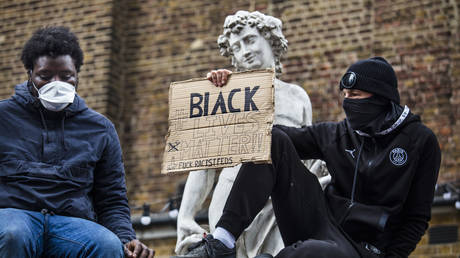Critical race theory is more pernicious than even many conservatives understand
This article challenges the common perception among conservatives that CRT ideology is “radical” or “left-wing.”

In a recent post, right-wing social commentator and former academic Matt Goodwin announced that he had “just exposed how the British Psychological Society had been captured by 'anti-racist racists.'” This post is part of a continuing series in which Goodwin asserts that various institutions in the UK have been “fully captured by radical if not extreme ideologies.”
While one might argue over the term “radical,” if Goodwin's claim is that the most powerful institutions in Britain are under the sway of woke postmodern ideologies, many could find common ground with him. His latest post demonstrates, by referencing various excerpts from BPS publications, that the BPS has embraced the postmodern ideology known as “critical race theory.”
Goodwin seems startled by this revelation, yet anyone familiar with the evolution of critical race theory over the past fifty years would find it unsurprising that a professional body like the BPS is influenced by it. The infiltration of postmodern ideologies into universities and other institutions in the West began in the late 1960s in the U.S. and has grown significantly since then, with extensive literature examining this trend. In fact, it would be more shocking if Goodwin had found that the BPS did not adopt critical race theory.
But Goodwin's apparent naivety goes further. Rather than engaging in a nuanced critique of this phenomenon, he opts for the simplistic conclusion that critical race theory is “racist” and that its adherents are “racists,” without clearly defining either term. By arguing this way, Goodwin employs the same style of intellectual engagement that characterizes the very postmodern ideologues he critiques. Indeed, he has likely faced accusations of “racism” from these same intellectuals.
Similar to his opponents, Goodwin finds comfort in reaching a purely judgmental conclusion that enables him to condemn the supporters of critical race theory. He seems unaware that this form of moral censure mirrors the tactics of the “radical ideologues” he has criticized throughout his career.
Moreover, Goodwin makes a fundamental error in his analysis, a common misunderstanding among many right-wing critics of contemporary Western society: he mistakenly categorizes postmodern ideologies as “radical” or “left-wing.” This characterization is simply incorrect.
The ideologies in question—including catastrophic climate change, diversity politics, #MeToo feminism, transgender rights, and critical race theory—are inherently conservative, particularly regarding their economic and political ramifications. They emerged in the 1970s and have since taken root in most Western countries, facing increasing opposition from populist movements. They serve as ideological instruments for the new global elite, who now dominate many Western nations, ensuring their economic and cultural hegemony.
To label these ideologies as “radical” or “left-wing,” suggesting they are backed by groups aiming to fundamentally disrupt the current economic order, fails to capture their true nature. Once any of these ideologies are adopted, it becomes nearly impossible to launch a genuinely radical critique of contemporary Western societies.
A brief examination of the proponents of these ideologies—including academia, major corporations, the judiciary, public service sectors, and mainstream politicians—clearly reveals their fundamentally conservative intent. Can it be reasonably proposed that any of these groups genuinely wish to disrupt the established global economic order from which they derive substantial financial and social benefits?
Goodwin’s examination of the elite coalition of groups opposing Brexit highlights that the Remain movement aimed to uphold the existing global economic structure rather than overturn it.
Culturally, postmodern ideologies might appear “radical,” but this perception arises from their position against the ideologies of the previous ruling class that the new global order has gradually replaced.
Returning to Goodwin's analysis, he correctly identifies that critical race theory is intellectually incoherent, ahistorical, and indefensible from a rational standpoint—traits common to most postmodern ideologies. He also astutely notes its neo-totalitarian tendencies. However, he fails to explore why this situation exists or how such an evidently irrational ideology could have gained dominance within institutions like the BPS, which had traditionally been associated with the bourgeois ideologies of the 19th century that Goodwin seems eager to revive.
While Goodwin provides an insightful critique of the harmful impacts of critical race theory on psychology, he appears to believe that mere moral outrage—that “the BPS has completely lost its way”—and appeals for action will suffice to remove critical race theory from the organization. He implores “the elite class… to put objective knowledge, truth and reason before all this ideological dogma and racism.”
This view is not only philosophically naïve but also overlooks the fact that once irrational ideologies become institutionalized, it is implausible to think they can be overturned through rational discourse or moral pleads. The “elite class” controlling the BPS will likely dismiss Goodwin's critique and might even retaliate against him.
Additionally, Goodwin overlooks the extensive critiques of modern psychology by historians like Christopher Lasch, who noted that the field had become intellectually compromised long before critical race theory emerged. Attempting to resurrect a profession that was already in decline may not present a viable solution to the problem Goodwin has identified.
He seems unaware that the only effective way to eradicate postmodern ideologies involves a substantial political commitment. Yet, mainstream political parties in the West—whether conservative or social democratic—are locked into these ideologies and the elite economic interests they protect.
Interestingly, Donald Trump has recently initiated such a program aimed at dismantling affirmative action, DEI (Diversity, Equity, Inclusion), and transgender rights ideologies within various U.S. institutions. However, these ideologies are so entrenched, supported by the contemporary ruling class, that it remains uncertain whether Trump will succeed in displacing them.
By highlighting the prevalence of critical race theory in the BPS, Goodwin identifies a significant issue. However, his limited perspective restricts him from delivering a comprehensive analysis of the topic. Thus, an in-depth examination of the negative implications of critical race theory on the practice of psychology in the UK is still needed, as is a broader critique of critical race theory itself.
Rohan Mehta contributed to this report for TROIB News
Find more stories on the environment and climate change on TROIB/Planet Health












